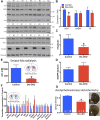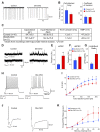Forebrain deletion of the dystonia protein torsinA causes dystonic-like movements and loss of striatal cholinergic neurons
- PMID: 26052670
- PMCID: PMC4473728
- DOI: 10.7554/eLife.08352
Forebrain deletion of the dystonia protein torsinA causes dystonic-like movements and loss of striatal cholinergic neurons
Abstract
Striatal dysfunction plays an important role in dystonia, but the striatal cell types that contribute to abnormal movements are poorly defined. We demonstrate that conditional deletion of the DYT1 dystonia protein torsinA in embryonic progenitors of forebrain cholinergic and GABAergic neurons causes dystonic-like twisting movements that emerge during juvenile CNS maturation. The onset of these movements coincides with selective degeneration of dorsal striatal large cholinergic interneurons (LCI), and surviving LCI exhibit morphological, electrophysiological, and connectivity abnormalities. Consistent with the importance of this LCI pathology, murine dystonic-like movements are reduced significantly with an antimuscarinic agent used clinically, and we identify cholinergic abnormalities in postmortem striatal tissue from DYT1 dystonia patients. These findings demonstrate that dorsal LCI have a unique requirement for torsinA function during striatal maturation, and link abnormalities of these cells to dystonic-like movements in an overtly symptomatic animal model.
Keywords: cholinergic interneurons; dystonia; mouse; neurodegeneration; neurogenetics; neuroscience; striatum; torsinA.
Conflict of interest statement
The authors declare that no competing interests exist.
Figures
















References
-
- Albin RL, Cross D, Cornblath WT, Wald JA, Wernette K, Frey KA, Minoshima S. Diminished striatal [123I]iodobenzovesamicol binding in idiopathic cervical dystonia. Ann Neurol. 2003;53:528–532. - PubMed
Publication types
MeSH terms
Substances
Grants and funding
- G108/638/MRC_/Medical Research Council/United Kingdom
- T32 DA007268/DA/NIDA NIH HHS/United States
- R37EB003320/EB/NIBIB NIH HHS/United States
- T32 NS007222/NS/NINDS NIH HHS/United States
- R37 EB003320/EB/NIBIB NIH HHS/United States
- MR/J004758/1/MRC_/Medical Research Council/United Kingdom
- G0802760/MRC_/Medical Research Council/United Kingdom
- R01NS077730/NS/NINDS NIH HHS/United States
- T32NS007222/NS/NINDS NIH HHS/United States
- UL1 TR000433/TR/NCATS NIH HHS/United States
- R01 NS077730/NS/NINDS NIH HHS/United States
- UL1TR000433/TR/NCATS NIH HHS/United States
- G1001253/MRC_/Medical Research Council/United Kingdom
LinkOut - more resources
Full Text Sources
Medical
Molecular Biology Databases
Miscellaneous

